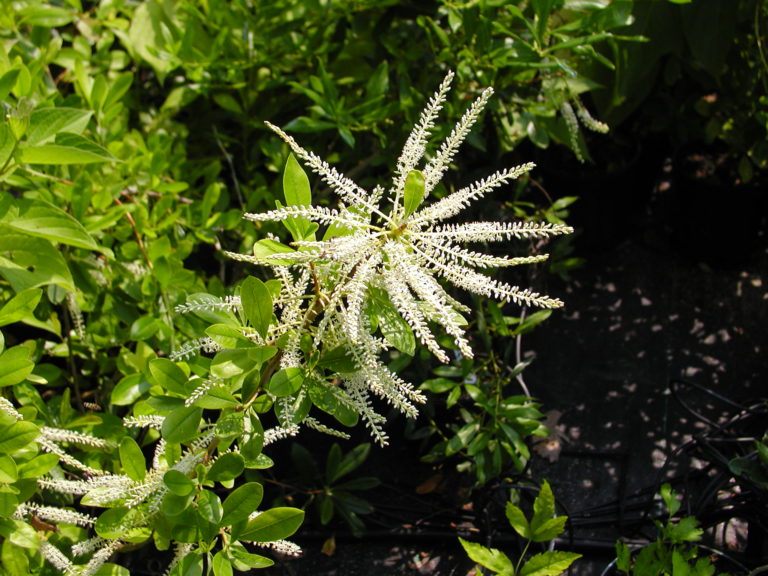Swamp Titi is an extremely interesting and underused shrub or small tree for our area. It grows to perhaps 20 feet (more often 12-15 feet) and can be described as having both lustrous evergreen or tardily deciduous leaves and colorful fall foliage! Its trunk(s) and branches are very nicely contorted, with cinnamon-colored bark (maturing to grayish, exfoliating), and it puts on a long-lasting, stunning floral display in the summer, followed by seeds attractive to birds. In the Southern U.S., it is found in swamps. bogs, pocosins, wet places in the piedmont and coastal plains from Virginia around to Texas and is associated with Bald Cypress, Pond Cypress, Tupelos, Sweetbays, Redbays and Atlantic White Cedar. But its range extends much further, through the Caribbean to Central and northern South America. In these tropical places the trees are much taller, and evergreen. We have collected seeds from shrubs/trees growing in thickets or colonies pond-side in the Sandhills. Like many plants originating in wet places, Titi grows well in upland soils as well. This is a beautiful plant.
NURSERY HOURS
Wednesday: 10-4 Thursday: 10-6 Friday-Saturday: 10-4 Sunday: 12-4
Cyrilla racemiflora

Key Info
Scientific Name: Cyrilla racemiflora L.
Common Names: Titi, Swamp Cyrilla, Swamp Titi, Littleleaf Titi, He-Huckleberry, Leatherwood, Red Titi, White Titi, Black Titi, Palo Colorado
Family Names: Cyrillaceae (Titi Family)
Plant Type: Tree / Shrub
Leaf Retention: Semi-evergreen
Flower Color: White
Special Characteristics: Showy fruit, Attracts bees, Interesting bark, Evergreen, Good fall color, Fragrant flowers, Tolerates wet conditions, Interesting form, Rhizomatous
Additional Info
Habit: Shrubby when young, this plant will eventualy devleop into a small tree with contorted stems, smooth, rust-colored young bark, flaky mature bark, and shallow root system..
Height: 8' to 20'
Spread: 5'-10'
Soil Conditions: Moist well drained to wet; acid to circumneutral pH, organic, sandy, sandy loam, loamy clay soils.
Leaves: Alternate, simple, with entire margins, 3-4" long; leathery, lustrous dark green above, lighter below. In our climate some of the leaves turn bright red and hang on to plant until the spring when it sets new leaves.
Flowers (or reproductive structures: Drooping sprays (racemes) 4-6" long of small, perfect, bright white flowers form around stems.
Fruit: The sprays of small white flowers develop into sprays of dry capsules with several seeds each in fall.
Natural Distribution: Wet pinelands, stream banks, swamps and pocosins in coastal and sandhill counties.
USDA Hardiness Zone: 5 to 11
USDA Wetland Indicator Status in NC: FACW
Pollination: Bees
Wildlife Connections: Birds and small mammals eat the fruit. In nature, Titi can form thickets favored by small mammals and birds for cover and nesting.
Propagation: From seed, from root cuttings in fall or winter, from softwood cuttings in early summer.
